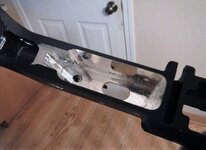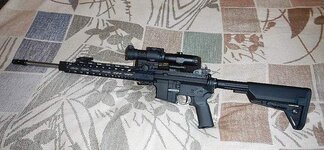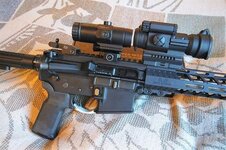I'm curious if anyone has used this jig and would have any tips or tricks for us.
This is a new project for us (my son and I) after completing several Glock 80% builds. The lowers we have are 7075-T6 anodized.
Some questions that would welcome some insight:
1. I don't own a drill press (or rather... one that I would trust for precision drilling) and were planning on doing the start hole with a hand drill. Every tutorial we've seen (even from 80percentarms) have been done with a drill press and no mention of any tips on using a hand drill... even though one of the main selling points of this jig is that no drill press is needed.
They highly stress using the included level to ensure all surfaces and equipment are level and aligned. I don't know if that's simply because a drill press may be more likely to damage the drill hole guide or because the exit hole alignment is absolutely critical. It doesn't seem like it should matter while milling since the router simply needs a start position as the depths increase. How critical the lower exit hole is though... I dunno.
I don't know how much the hole guide helps with alignment when using a hand drill... or even if the concern has any merit if reasonable care it taken to keep the drill in an upright position. ;-)
*Note: I did opt to get the drill stablizers for the side holes.
2. We're thinking of using a single layer of painters tape to protect the lowers finish. Is that likley to interfer with alignments? Good/bad idea?
3. We have aluma hyde (spray) and planning on sealing the raw aluminum with it after milling. I don't know if we should bake them after application or simply let them cure for the 2 week period. Thought on that... or using aluma hyde in general would be welcome. Again.. these are anodized lowers. I didn't plan on spraying the outsides too, but also don't know what issues we run into baking pre-anodized aluminum
I'm sure the "safest" would be to just let them cure... but that's TWO whole friggin weeks to wait.
4. The router I have is a double hander so I had to purchase (seperately) the large router plate. The day after it arrived I ran into a thread that was saying it's better to use a smaller router controllable with one hand. I guess they found a large router was more difficult to control on the jib plate(?). Just supposition on my part. Maybe the guy just wasn't familar with more powerful hand tools.
My thought being... well... I admit I'm a bit predisposed to, "more power is more better" when it comes to tools, trucks and firearms. After all... it "is" 7075-T6 so I'm thinking low speed, more torque would be preferrable (?)
Any other thoughts or experiences are welcome... or simply on the builds in general. This is the first time doing any kind of AR build for both of us.
Appreciate your time and combined learned thoughts or advice for us noob builders.
(I've read the sticky 80% thread but was looking for more easy jig 2 specific info and our planned approach.)
This is a new project for us (my son and I) after completing several Glock 80% builds. The lowers we have are 7075-T6 anodized.
Some questions that would welcome some insight:
1. I don't own a drill press (or rather... one that I would trust for precision drilling) and were planning on doing the start hole with a hand drill. Every tutorial we've seen (even from 80percentarms) have been done with a drill press and no mention of any tips on using a hand drill... even though one of the main selling points of this jig is that no drill press is needed.
They highly stress using the included level to ensure all surfaces and equipment are level and aligned. I don't know if that's simply because a drill press may be more likely to damage the drill hole guide or because the exit hole alignment is absolutely critical. It doesn't seem like it should matter while milling since the router simply needs a start position as the depths increase. How critical the lower exit hole is though... I dunno.
I don't know how much the hole guide helps with alignment when using a hand drill... or even if the concern has any merit if reasonable care it taken to keep the drill in an upright position. ;-)
*Note: I did opt to get the drill stablizers for the side holes.
2. We're thinking of using a single layer of painters tape to protect the lowers finish. Is that likley to interfer with alignments? Good/bad idea?
3. We have aluma hyde (spray) and planning on sealing the raw aluminum with it after milling. I don't know if we should bake them after application or simply let them cure for the 2 week period. Thought on that... or using aluma hyde in general would be welcome. Again.. these are anodized lowers. I didn't plan on spraying the outsides too, but also don't know what issues we run into baking pre-anodized aluminum
I'm sure the "safest" would be to just let them cure... but that's TWO whole friggin weeks to wait.
4. The router I have is a double hander so I had to purchase (seperately) the large router plate. The day after it arrived I ran into a thread that was saying it's better to use a smaller router controllable with one hand. I guess they found a large router was more difficult to control on the jib plate(?). Just supposition on my part. Maybe the guy just wasn't familar with more powerful hand tools.
My thought being... well... I admit I'm a bit predisposed to, "more power is more better" when it comes to tools, trucks and firearms. After all... it "is" 7075-T6 so I'm thinking low speed, more torque would be preferrable (?)
Any other thoughts or experiences are welcome... or simply on the builds in general. This is the first time doing any kind of AR build for both of us.
Appreciate your time and combined learned thoughts or advice for us noob builders.
(I've read the sticky 80% thread but was looking for more easy jig 2 specific info and our planned approach.)
Last Edited:














